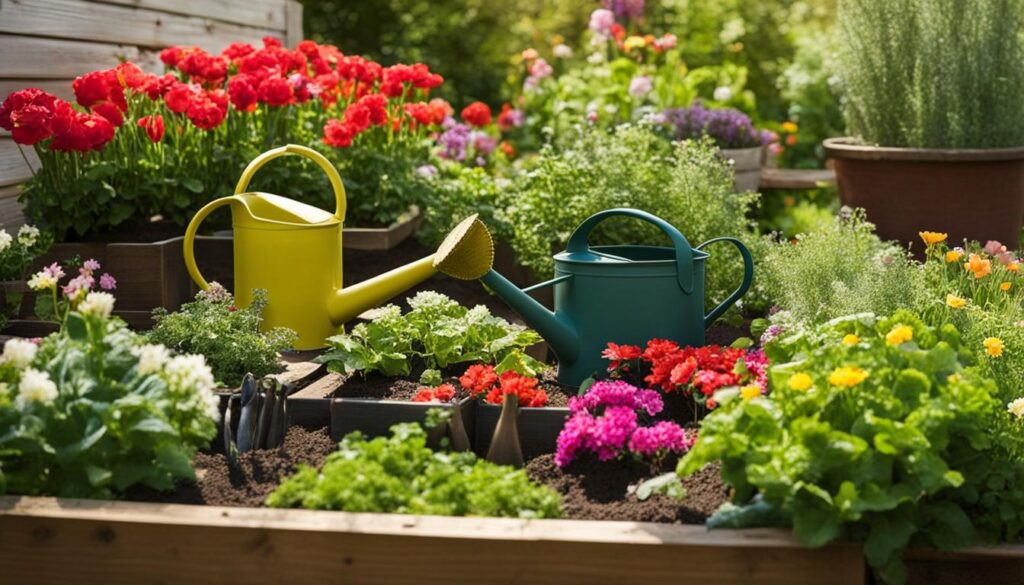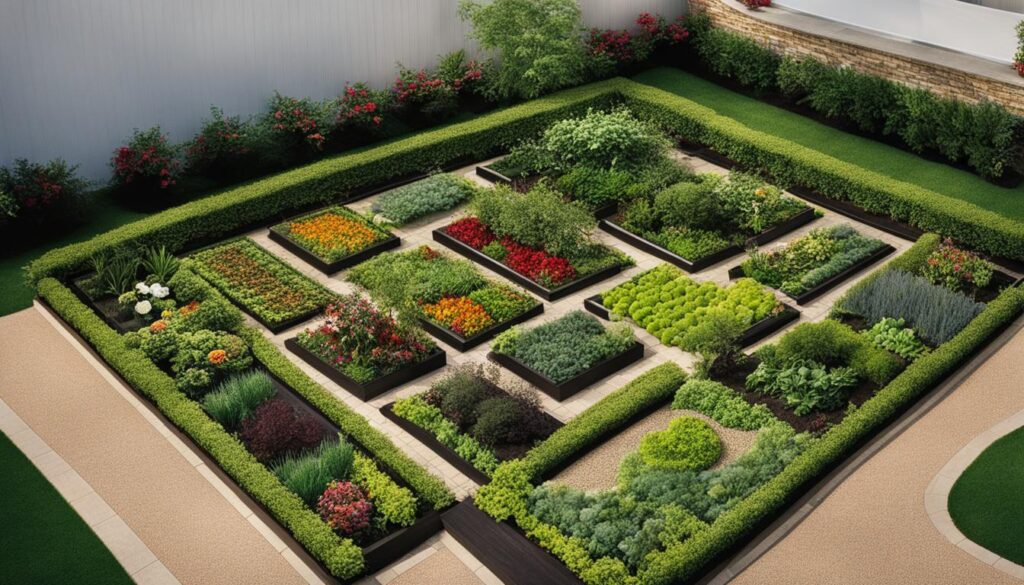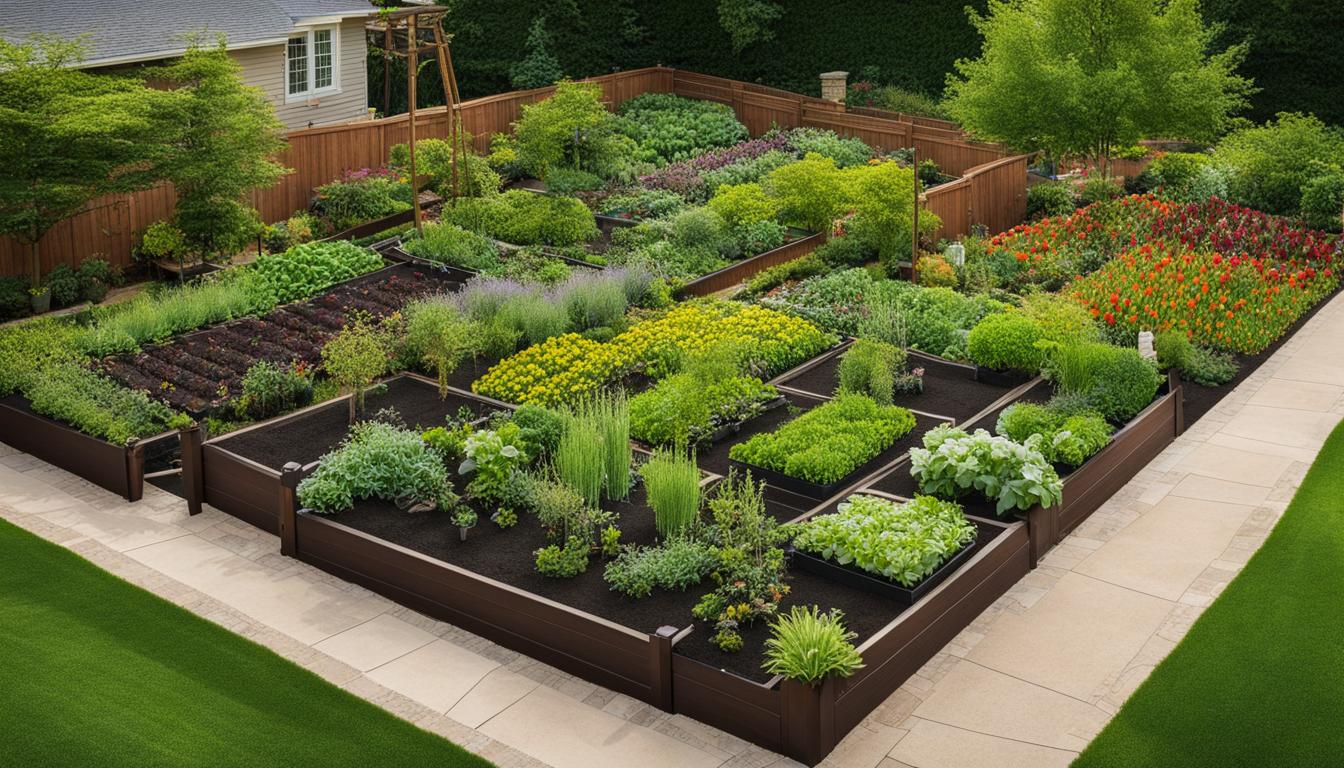Just as you give your house a good spring cleaning to freshen it up after a long winter, you can take a similar approach to getting your garden in shape for the warmer months. Tackle all your outdoor tasks like a pro with this spring gardening checklist. It’s divided into early, middle, and late spring tasks to help you pace yourself as you get your flowerbeds, trees, shrubs, and other garden areas ready for the growing season. Clear away dead leaves or any other winter debris, divide perennials, add a fresh layer of mulch, prune fruit trees, and check your stonework for frost heaves. These are just a few of the tasks that will ensure your garden thrives year-round.
Key Takeaways:
- The Ultimate Garden Checklist helps you stay organized and keep your garden in top shape.
- Year-round garden maintenance is essential for a thriving garden.
- Following a garden checklist ensures you don’t miss any important tasks.
- Divide your gardening tasks into early, middle, and late spring for better organization.
- Tasks such as clearing debris, adding mulch, pruning trees, and checking stonework contribute to a successful gardening season.
Note: Please remember that the placement of the image should be in the center, not left or right-aligned.
Early Spring Tasks
In early spring, when temperatures begin trending upward and plants start to break dormancy, there are several tasks you should focus on. It’s time to roll up your sleeves and give your garden the care it needs for a successful season ahead.
As the winter frost subsides, it’s essential to clear away any debris that has accumulated over the colder months. Remove fallen leaves and dead foliage from the soil surfaces to allow new growth to emerge unimpeded.
Another crucial task is to remove any protective winter mulch that you may have applied to insulate your plants. This will prevent the mulch from hindering the growth of new shoots.
Take the opportunity to cut back any dried foliage and stems from your perennials. This helps stimulate new growth and ensures the health and vitality of your plants.
“By clearing away debris and preparing the soil, you create a clean canvas for your garden to flourish.”
When working in your garden, it’s advisable to wear gloves to protect your hands from prickly plants and any hidden thorns.
This is also the perfect time to divide your perennials, such as daylilies or hostas. Dividing these plants helps maintain their health and promotes new growth.
Adding a fresh layer of mulch around your plants is an important step in creating a healthy and thriving garden. The mulch helps to retain moisture, suppress weeds, and regulate the soil temperature.
Pruning fruit trees is another crucial task to undertake during this period. Proper pruning helps shape the tree, improves airflow, and encourages optimal fruit production.
“Early spring tasks lay the groundwork for a flourishing garden.”
While tending to your garden, remember to check your stonework for any signs of damage caused by winter frost. Make the necessary repairs to ensure the structural integrity of the garden.
By completing these early spring tasks, you set the stage for a successful and bountiful gardening season. Your garden will be ready to embrace the warmer weather and burst into vibrant life.
Mid-Spring Tasks
Halfway through the season, as more plants start growing and blooming, it’s time to focus on adding new plants to your garden. Mid-spring is an exciting time of growth and renewal, and there are a few essential tasks to prioritize for a thriving garden.
1. Take down bird feeders
As the weather warms up, birds have an abundance of natural food sources available. It’s a good idea to take down your bird feeders during mid-spring to encourage birds to seek out their own food and reduce dependence on feeders.
2. Remove spent blossoms from bulbs
After your spring-flowering bulbs have finished blooming, it’s important to remove the spent blossoms. This process, known as deadheading, encourages energy storage for next year’s blooms and maintains the overall health of the bulbs.
3. Plant cool-season annuals
Add quick bursts of color to your garden by planting cool-season annuals during mid-spring. These plants, such as pansies and snapdragons, thrive in cooler temperatures and provide vibrant blooms that can withstand lingering chilly weather.
4. Plant trees and shrubs
If the ground is no longer frozen and the weather is favorable, mid-spring is an excellent time to plant trees and shrubs. The moderate temperatures and ample moisture support healthy root growth, giving your new additions the best chance to establish themselves.
5. Mulch around new plants
Before the summer heat kicks in, apply a layer of mulch around newly planted trees, shrubs, and perennials. Mulch helps to suppress weed growth, retain moisture in the soil, and provide insulation for the plants’ roots.
“Mid-spring is a busy time in the garden, with new growth and fresh blooms transforming outdoor spaces. By following these mid-spring tasks, you’ll ensure your garden flourishes with vibrant colors and healthy plants.” -Gardening Expert

With these mid-spring tasks completed, your garden will be well-prepared for the upcoming summer months. Stay tuned for the next section, where we’ll discuss the essential tasks for late spring and how to keep your garden thriving all season long.
Late Spring Tasks
In late spring, it’s time to continue the care and maintenance of your garden. As summer approaches, there are several important tasks to focus on to ensure your garden remains vibrant and abundant. Follow these monthly garden tasks to keep your garden thriving throughout the season.
Cleaning Up and Preparing for More Planting
One of the first tasks in late spring is cleaning up flowers that have already bloomed. Removing spent blossoms from spring-flowering bulbs not only tidies up the garden but also encourages energy storage for the next year’s blooms.
To create a lush and colorful garden, choose summer annuals that will add vibrancy and texture. Transplant seedlings of warm-season crops like tomatoes and peppers, ensuring they have plenty of space to grow and develop strong roots.
As the threat of frost subsides, it’s safe to plant summer-blooming bulbs. These plants will bring beauty and abundance to your garden as the temperatures rise and summer progresses.
Garden Care Schedule – Late Spring Tasks
| Task | Description |
|---|---|
| Remove spent blossoms from spring-flowering bulbs | Prune off the faded blooms to encourage energy storage |
| Choose and plant summer annuals | Select vibrant and hardy annuals for summer color |
| Transplant seedlings of warm-season crops | Move young plants of tomatoes, peppers, and other summer vegetables to their permanent location |
| Plant summer-blooming bulbs | Add bulbs like dahlias, gladiolus, and lilies to ensure a stunning display throughout the season |
By completing these late spring tasks, you’ll set the stage for a vibrant and thriving garden as summer arrives. Stay on track with your garden care schedule and enjoy the beauty and abundance that your garden will provide.
Choosing the Garden Location
Before starting a new garden, it’s important to choose the right location. The success of your garden depends on factors such as sunlight, water accessibility, shade, wind exposure, and soil condition. By considering these elements, you can create an optimal environment for your plants to thrive.
- Sunlight: Most vegetables and flowering plants require 6-8 hours of full sun each day. Choose a location that receives adequate sunlight throughout the day.
- Water Source: Ensure easy access to a water source to simplify watering tasks. This could be a nearby outdoor spigot, rain barrel, or irrigation system.
- Shade: Take note of any areas in your garden that are shaded, either from neighboring buildings, trees, or tall plants. Some plants, like leafy greens, prefer partial shade, while others require full sun.
- Wind Exposure: Evaluate how much wind your potential garden location receives. Strong winds can damage plants and cause drying of the soil. Consider planting windbreaks, such as hedges or fences, to protect your garden from excessive wind.
- Soil Condition: Assess the quality of the soil in your chosen location. Avoid areas with poorly drained or compacted soil, as these conditions can hinder plant growth. Conduct a soil test to determine nutrient levels and pH, and amend the soil as needed.
A clever solution for areas with challenging soil conditions is to use raised beds. Raised beds provide better drainage and make it easier to control soil quality. They also create distinct planting areas within your garden.
By carefully selecting the optimal garden location, you set the stage for a thriving garden that will bring you joy and abundance. Let’s take a closer look at planning the layout of your garden in the next section.

Planning the Garden Layout
Now that you’ve chosen the perfect location for your garden, it’s time to plan the layout. This step is crucial to ensure efficiency, functionality, and visual appeal. By strategically arranging your plants, pathways, and structures, you can create a garden that is easy to maintain and enjoyable to experience.
Optimize with Narrow Beds
When designing your garden layout, consider implementing narrow beds that are around 4 feet wide. These narrow beds allow for easy access and convenient maintenance. They also facilitate crop rotation, a vital practice that helps prevent soil-borne diseases and promotes healthy plant growth. With narrow beds, you’ll have better control over your plants and can achieve higher yields.
Create Accessible Pathways
Incorporate wide pathways into your garden layout to ensure easy access and maneuverability. Wide pathways not only provide a clear route for you to navigate while tending to your plants but also allow for the use of wheelbarrows and gardening equipment. Well-designed pathways improve overall garden accessibility and prevent trampling on delicate plants.
Strategically Place Structures
While planning your garden layout, take into account the placement of structures such as composting areas and seating areas. Position your composting area near the garden beds for easy access when adding organic matter or turning the compost. Create enticing seating areas where you can relax and admire your garden’s beauty. Consider placing these structures in shaded areas or near plants that release pleasant fragrances.
Designing an efficient and enjoyable garden layout is essential for the success of your gardening endeavors. Consider these tips as you plan your garden, and remember to prioritize functionality, accessibility, and aesthetic appeal.
When complete, your well-planned garden layout will enhance your gardening experience and ensure that your plants have the space to thrive.

| Benefits of Planning the Garden Layout |
|---|
| Facilitates maintenance and crop rotation |
| Provides easy access and maneuverability |
| Optimizes plant placement for better growth |
| Enhances garden functionality |
| Creates a visually appealing garden |
Clearing Weeds and Preparing the Soil
Before planting, it’s essential to prepare the soil by clearing weeds and improving its condition. Removing weeds not only improves the aesthetics of your garden, but it also helps prevent competition for nutrients and water. Here are some steps to follow:
-
Remove Larger Rocks and Debris: Start by clearing the area of any large rocks, branches, or other debris that may hinder plant growth or interfere with gardening activities.
-
Smother Weeds with Organic Matter: An effective method to suppress weeds is by smothering them using organic matter like compost along with layers of newspaper or cardboard. This creates a barrier that prevents sunlight from reaching weed seeds, inhibiting their growth.
-
Conduct a Soil Test: A soil test is crucial as it helps determine nutrient deficiencies and pH levels. You can obtain a soil test kit from your local garden center or send a sample to a laboratory for a more comprehensive analysis.
-
Amend the Soil: Based on the results of the soil test, you can amend the soil by adding organic matter such as compost, well-rotted manure, or other suitable soil conditioners. This improves soil structure, adds essential nutrients, and enhances fertility.
Preparing the soil through weed clearance and soil improvement creates an optimal environment for your plants to thrive. With a nutrient-rich and well-aerated soil, your garden will have a solid foundation for healthy growth and abundant harvests.
Take a look at the table below for a visual summary of the steps involved in clearing weeds and preparing the soil:
| Steps | Description |
|---|---|
| 1 | Remove larger rocks and debris |
| 2 | Smother weeds with organic matter |
| 3 | Conduct a soil test |
| 4 | Amend the soil with organic matter |

Choosing and Planting Your Garden
Now that you’ve prepared your garden space, it’s time to choose the perfect plants to bring it to life. Whether you have a preference for vegetables, herbs, or flowers, selecting the right plants that are suitable for your climate, soil, and sunlight conditions is essential for a thriving garden.
Consider whether you want to start from seeds or purchase young plants for transplanting. Starting from seeds allows you to have a wider variety of plant options and can be a rewarding experience. However, if you prefer a more convenient option, transplanting young plants can save you time and ensure a head start in your garden’s growth.
When it comes to planting, follow proper techniques to give your plants the best start. Dig the appropriate-sized hole for each plant and gently loosen the roots before placing them in the hole. Ensure that the soil is well-drained and amend it if needed with compost or organic matter to improve its fertility.
Regular watering is crucial after planting to establish strong root systems and encourage healthy growth. Check the moisture level of the soil and water your plants as needed, being careful not to overwater, which can lead to root rot. Mulching the soil around your plants will help retain moisture, regulate soil temperature, and prevent weed growth.
“The love of gardening is a seed once sown that never dies.”
– Gertrude Jekyll
Remember, choosing and planting the right plants is the key to a thriving garden. Take into account the specific needs of each plant, from sunlight requirements to soil pH, and provide the care and attention they need. With proper selection and planting, your garden will flourish and bring you joy throughout the growing season.
Conclusion
Starting a new garden can be a rewarding experience, but it’s important to have a plan and follow a checklist to ensure success. By dividing tasks into early, mid, and late spring, you can stay organized and keep your garden in top shape. Choosing the right garden location, planning the layout, clearing weeds, and improving the soil are crucial steps for a thriving garden.
Carefully selecting and planting your chosen plants, along with proper watering and maintenance, will help your garden flourish year-round. Follow this ultimate garden checklist for a beautiful and productive garden. Remember to tailor your tasks based on the specific month to stay on track and optimize results. With a little dedication and these thriving garden tips, you’ll be rewarded with a vibrant and abundant garden that will bring joy and satisfaction for years to come.
FAQ
What is the ultimate garden checklist for year-round garden maintenance?
The ultimate garden checklist includes tasks for early, mid, and late spring, as well as choosing the right garden location, planning the layout, clearing weeds, preparing the soil, and choosing and planting your garden. Following this checklist will help ensure a thriving garden all year long.
What are the early spring tasks for my garden?
Early spring tasks for your garden include clearing away winter debris, removing protective winter mulch, cutting back dried foliage, dividing perennials, adding fresh mulch, pruning fruit trees, and checking stonework for damage.
What are the mid-spring tasks for my garden?
Mid-spring tasks for your garden include taking down bird feeders, removing spent blossoms from bulbs, planting cool-season annuals, and planting trees and shrubs.
What are the late spring tasks for my garden?
Late spring tasks for your garden include removing spent blossoms from spring-flowering bulbs, choosing and transplanting seedlings of warm-season crops, and planting summer-blooming bulbs.
How do I choose the right garden location?
When choosing a garden location, consider the amount of sunlight the area receives, accessibility to a water source, shade, wind exposure, and soil condition. Avoid poorly drained or compacted areas and consider using raised beds for better drainage.
What should I consider when planning the garden layout?
When planning the garden layout, opt for narrow beds for easy maintenance and crop rotation. Include wide paths for accessibility and consider the placement of structures like composting areas and seating areas.
How do I clear weeds and prepare the soil for my garden?
Clearing weeds involves removing larger rocks and debris, smothering weeds with newspaper and organic matter, and conducting a soil test to determine nutrient deficiencies. Improving the soil can be done by adding organic matter like compost or well-rotted manure.
How do I choose and plant my garden?
Choosing and planting your garden involves deciding on the type of plants suitable for your climate, soil, and sunlight conditions. Consider planting options from seeds or purchasing young plants for transplanting. Follow proper planting techniques and provide regular watering and mulching for optimal growth.
What is the ultimate garden checklist for success?
The ultimate garden checklist includes yearly tasks divided into early, mid, and late spring, as well as choosing the right garden location, planning the layout, clearing weeds, preparing the soil, and choosing and planting your garden. Following this checklist will help ensure a beautiful and productive garden.

